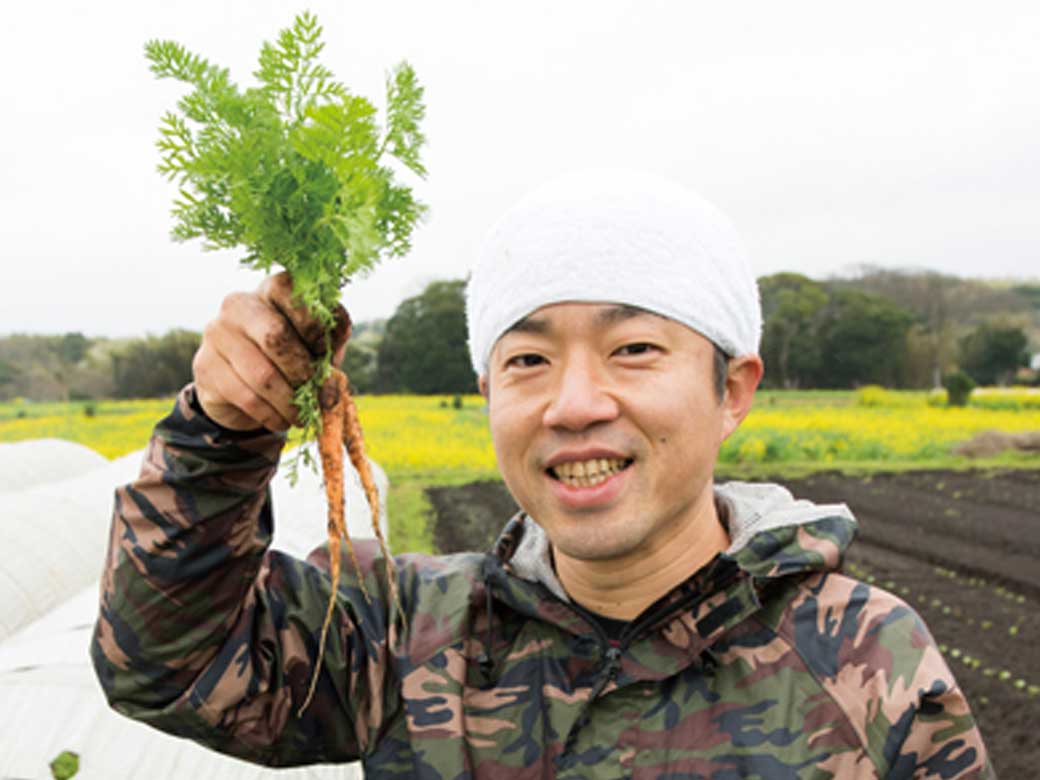Protecting vegetable crop diversity – Alumnus highlight
Fri, May 29, 2015-
Tags
Masayuki Miyamoto’s “Miyamoto Agriculture”
“Native vegetables” are vegetables with a long history of cultivation in one area and become inseparable from its dietary culture. Well-known examples are native eggplants found in Kyoto and red carrots in Shikoku. In Kimitsu city of Chiba prefecture, farmer Masayuki Miyamoto is producing native vegetables in harmony with nature.
“I tried soybeans from Koito river in Kimitsu city for the first time at an agricultural event and was surprised by its delicious flavor. I had never paid much attention to soybean flavor. After that I visited many farmers and among the most delicious vegetables I tried, many were native crops from that area.”
Enchanted by the natural flavor of native vegetables, Miyamoto moved from Tokyo to Kimitsu in 2011. As a farming newcomer, Miyamoto spent his days learning by trial and error. Miyamoto says he never intended on becoming a farmer and was not the type of person to end up in Kimitsu. He is now seeking to live life in alignment with his own interests.
Moving about as a farmer
Miyamoto’s first obsession was Chinese language. He entered the Chinese language club in university and studied Chinese enthusiastically with friends. He worked in an IT company for three years upon graduating and in a complete change of events became a day trader while helping to manage a relative’s real-estate agency. He eventually obtained qualifications to become a registered real-estate broker.
While traveling around to meet clients as a day trader, Miyamoto grew interested in the relationship between crops and weather. “I noticed that the price of soybeans would change drastically depending on things such as a change in course of an incoming typhoon. This was extremely interesting and compelled me to study meteorology.”
In a display of prowess and enthusiasm, Miyamoto obtained qualifications to become a weather forecaster, a qualification with a 5% pass rate. “It was around that time that I came into contact with Koito produce and began studying native vegetables at an organic plantation in Chiba. However, I hadn’t yet thought of becoming a farmer. Even my wife thought I would lose interest eventually (Laughs).”
Miyamoto, who originally never intended on working in agriculture, decided to become a farmer in Kimitsu, obtained land utilizing his knowledge as a real-estate broker, and built a new home. Needless to say, Miyamoto’s knowledge as a weather forecaster is invaluable when it comes to planting and harvesting crops. On top of this, Miyamoto traveled to Singapore this year in hopes of expanding his market overseas. “What helped me in Singapore was my Chinese language study in university. From a glance, my careers and studies appear to have no correlation. However, the reality is they all meet in my career as a farmer.

Miyamoto with a field of radish flowers he raised
What is crop diversity?
Miyamoto travels to the greater Tokyo area every week to deliver his organic produce to consumers. Currently his biggest concern is the issue of male sterility in crops.
“Presently, many vegetables are bred using a technique that makes plants produce sterile pollen. This technique has its origins in nature, but is a rare occurrence. I am discomforted by the fact that most vegetables in circulation are bred using this technique. Although there are merits to this type of selective breeding, I fear diversity in crops and dietary culture will deteriorate. For this reason I would like to promote the use of native vegetables.
Miyamoto is currently working on a carrot juice mix to meet the demands and needs of busy consumers. Miyamoto’s brimming sense of curiosity is boundless.
Masayuki Miyamoto
Masayuki Miyamoto was born in Hyogo Prefecture in 1976. In 2000 he graduated from Waseda University and began working at an IT company and real-estate agency. In 2009, he began researching organic farming in Sakura city located in Chiba prefecture. In 2011 he moved to Kimitsu city and began his career in agriculture.












